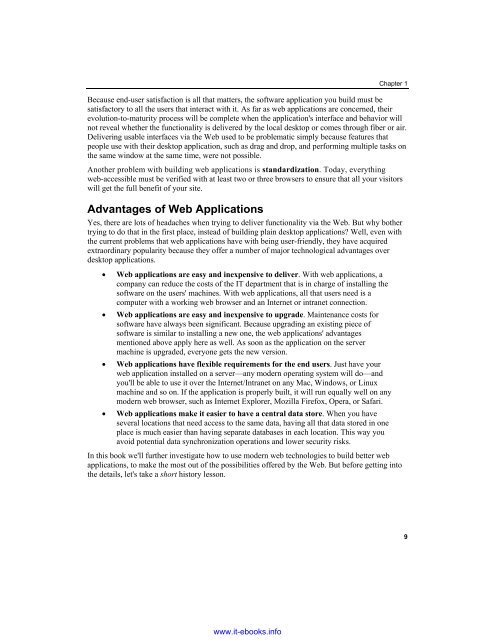AJAX and PHP
Create successful ePaper yourself
Turn your PDF publications into a flip-book with our unique Google optimized e-Paper software.
Chapter 1<br />
Because end-user satisfaction is all that matters, the software application you build must be<br />
satisfactory to all the users that interact with it. As far as web applications are concerned, their<br />
evolution-to-maturity process will be complete when the application's interface <strong>and</strong> behavior will<br />
not reveal whether the functionality is delivered by the local desktop or comes through fiber or air.<br />
Delivering usable interfaces via the Web used to be problematic simply because features that<br />
people use with their desktop application, such as drag <strong>and</strong> drop, <strong>and</strong> performing multiple tasks on<br />
the same window at the same time, were not possible.<br />
Another problem with building web applications is st<strong>and</strong>ardization. Today, everything<br />
web-accessible must be verified with at least two or three browsers to ensure that all your visitors<br />
will get the full benefit of your site.<br />
Advantages of Web Applications<br />
Yes, there are lots of headaches when trying to deliver functionality via the Web. But why bother<br />
trying to do that in the first place, instead of building plain desktop applications? Well, even with<br />
the current problems that web applications have with being user-friendly, they have acquired<br />
extraordinary popularity because they offer a number of major technological advantages over<br />
desktop applications.<br />
• Web applications are easy <strong>and</strong> inexpensive to deliver. With web applications, a<br />
company can reduce the costs of the IT department that is in charge of installing the<br />
software on the users' machines. With web applications, all that users need is a<br />
computer with a working web browser <strong>and</strong> an Internet or intranet connection.<br />
• Web applications are easy <strong>and</strong> inexpensive to upgrade. Maintenance costs for<br />
software have always been significant. Because upgrading an existing piece of<br />
software is similar to installing a new one, the web applications' advantages<br />
mentioned above apply here as well. As soon as the application on the server<br />
machine is upgraded, everyone gets the new version.<br />
• Web applications have flexible requirements for the end users. Just have your<br />
web application installed on a server—any modern operating system will do—<strong>and</strong><br />
you'll be able to use it over the Internet/Intranet on any Mac, Windows, or Linux<br />
machine <strong>and</strong> so on. If the application is properly built, it will run equally well on any<br />
modern web browser, such as Internet Explorer, Mozilla Firefox, Opera, or Safari.<br />
• Web applications make it easier to have a central data store. When you have<br />
several locations that need access to the same data, having all that data stored in one<br />
place is much easier than having separate databases in each location. This way you<br />
avoid potential data synchronization operations <strong>and</strong> lower security risks.<br />
In this book we'll further investigate how to use modern web technologies to build better web<br />
applications, to make the most out of the possibilities offered by the Web. But before getting into<br />
the details, let's take a short history lesson.<br />
9<br />
www.it-ebooks.info


